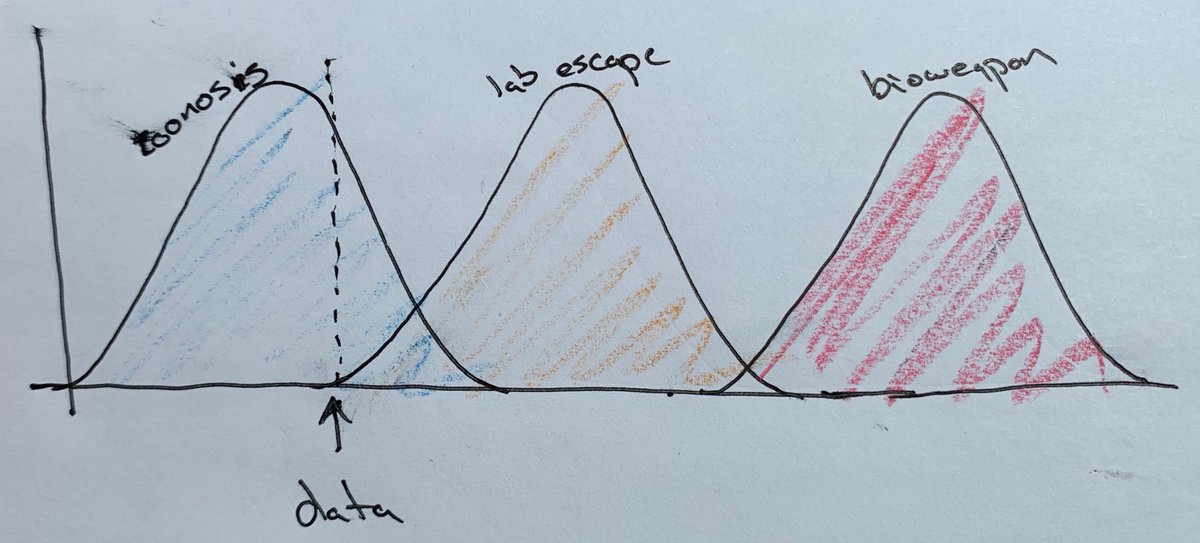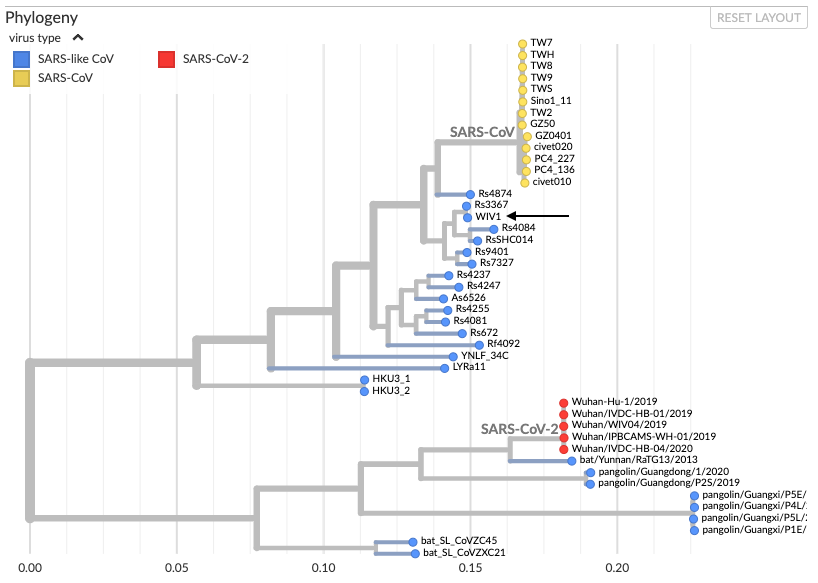I& #39;ve written before that #COVID19 has no evidence of genetic engineering and the "bioweapon" theory has no grounds. See, for example https://twitter.com/trvrb/status/1224207086013149184.">https://twitter.com/trvrb/sta... In this thread I wanted to directly address the theory of escape from lab in Wuhan. 1/21
We have public figures making televised statements promoting this lab escape theory and I believe it needs to be addressed directly. Not because it has evidence, but because a vacuum permits these theories room to expand. 2/21 https://www.washingtonpost.com/politics/2020/02/16/tom-cotton-coronavirus-conspiracy/">https://www.washingtonpost.com/politics/...
There is a nice "Bayesian" way to compare theories and think about evidence. I& #39;m showing the probability of observing the data at hand given different theories. We want to compare the likelihood of observing this data, compared to other outcomes consistent with a theory. 3/21
I& #39;ll go through each piece of data in turn, but my summary is that the data are fully consistent with a zoonotic origin, but is highly unlikely in the lab escape scenario (and vanishingly unlikely in the bioweapon scenario). 4/21
Data point #1 (virus group):
#SARSCoV2 is an outgrowth of circulating diversity of SARS-like viruses in bats. A zoonosis is expected to be a random draw from this diversity. A lab escape is highly likely to be a common lab strain, either exactly 2002 SARS or WIV1. 5/21
#SARSCoV2 is an outgrowth of circulating diversity of SARS-like viruses in bats. A zoonosis is expected to be a random draw from this diversity. A lab escape is highly likely to be a common lab strain, either exactly 2002 SARS or WIV1. 5/21
Note that previous non-zoonotic outbreaks have been obvious from genetic data, one example being the 1977 "Russian" flu, which was clearly a 1950s human virus that had been in a freezer for 20 years ( https://mbio.asm.org/content/6/4/e01013-15).">https://mbio.asm.org/content/6... 6/21
Or the lab acquired infection of researchers with SARS at China CDC in Beijing in 2004 ( https://genomebiology.biomedcentral.com/articles/10.1186/gb-spotlight-20040427-03).">https://genomebiology.biomedcentral.com/articles/... 7/21
Data point #2 (receptor binding domain):
This point is rather technical, please see preprint by @K_G_Andersen, @arambaut, et al at http://virological.org/t/the-proximal-origin-of-sars-cov-2/398">https://virological.org/t/the-pro... for full details. 9/21
This point is rather technical, please see preprint by @K_G_Andersen, @arambaut, et al at http://virological.org/t/the-proximal-origin-of-sars-cov-2/398">https://virological.org/t/the-pro... for full details. 9/21
But, briefly, #SARSCoV2 has 6 mutations to its receptor binding domain that make it good at binding to ACE2 receptors from humans, non-human primates, ferrets, pigs, cats, pangolins (and others), but poor at binding to bat ACE2 receptors. 10/21
This pattern of mutation is most consistent with evolution in an animal intermediate, rather than lab escape. Additionally, the presence of these same 6 mutations in the pangolin virus argues strongly for an animal origin: https://www.biorxiv.org/content/10.1101/2020.02.13.945485v1">https://www.biorxiv.org/content/1... 11/21
Data point #3 (market cases):
Many early infections in Wuhan were associated with the Huanan Seafood Market. A zoonosis fits with the presence of early cases in a large animal market selling diverse mammals. A lab escape is difficult to square with early market cases. 13/21
Many early infections in Wuhan were associated with the Huanan Seafood Market. A zoonosis fits with the presence of early cases in a large animal market selling diverse mammals. A lab escape is difficult to square with early market cases. 13/21
Data point #4 (environmental samples):
33 out of 585 environmental samples taken from the Huanan seafood market showed as #SARSCoV2 positive. 31 of these were collected from the western zone of the market, where wildlife booths are concentrated. 15/21
http://www.xinhuanet.com/english/2020-01/27/c_138735677.htm">https://www.xinhuanet.com/english/2...
33 out of 585 environmental samples taken from the Huanan seafood market showed as #SARSCoV2 positive. 31 of these were collected from the western zone of the market, where wildlife booths are concentrated. 15/21
http://www.xinhuanet.com/english/2020-01/27/c_138735677.htm">https://www.xinhuanet.com/english/2...
Environmental samples could in general derive from human infections, but I don& #39;t see how you& #39;d get this clustering within the market if these were human derived. 16/21
Data point #5 (location):
This is the only thing that has anything going for it for lab escape. But keep in mind, that there are other labs in China (if this had originated in Beijing, people would be accusing China CDC instead of the Wuhan Institute of Virology). 18/21
This is the only thing that has anything going for it for lab escape. But keep in mind, that there are other labs in China (if this had originated in Beijing, people would be accusing China CDC instead of the Wuhan Institute of Virology). 18/21
Still, the Wuhan location is more likely in the lab escape scenario than for the zoonotic scenario. But I believe we& #39;re talking about 1/20 odds rather than than 1/100 or 1/1000, as there are labs in multiple cities. 19/21
Overall, we have virus group, molecular features, market association and environmental samples all pointing strongly towards zoonosis. The location in Wuhan is the only thing at all suggestive of lab escape. I see strength of evidence entirely for zoonosis. 21/21
(This thread turned out longer than I expected. Thanks for sticking with me.)

 Read on Twitter
Read on Twitter



